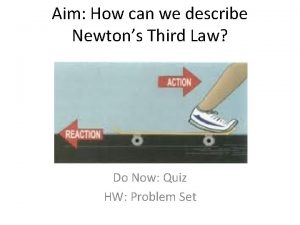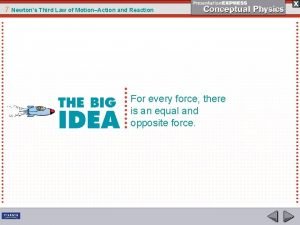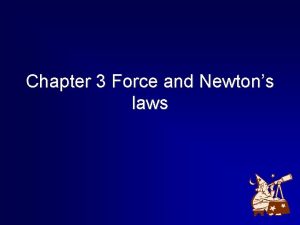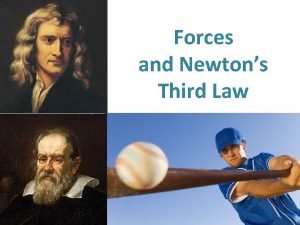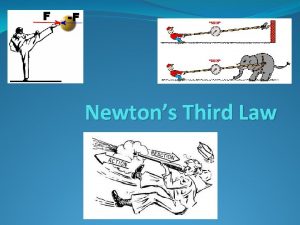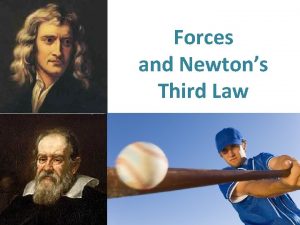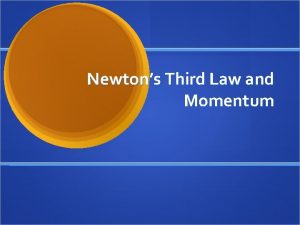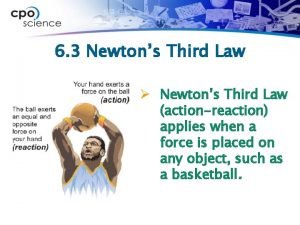Chapter 12 Forces Section 3 Newtons Third Law








- Slides: 8

Chapter 12: Forces Section 3: Newton’s Third Law of Motion

Standards • Standard 3: Motion • #2: Investigate and apply Newton’s three Laws of Motion • Embedded Math • #1: Understand the mathematical principles behind the science of physics • #2: Utilize appropriate mathematical equations and processes to solve basic physics problems

Objectives 1. 2. 3. 4. 5. State Newton’s third law of motion Identify force pairs and what the forces act on Define the term momentum Calculate momentum, mass, and velocity using the momentum equation State the law of conservation of momentum and apply this to real life events

Newton’s Third Law… Objective 1: State Newton’s Third law of motion • States… • For every action there is an equal and opposite reaction • In other words… • Forces act in pairs • Newton’s third law is sometimes called the law of action and reaction • Examples: • Kicking a soccer ball there are two forces • Force of the foot hitting the ball • Force of the ball hitting the foot

May the Force Pairs be With You • According to Newton’s 3 rd law • Forces act in pairs • Called action-reaction force • Do not act on the same object • Equal and opposite • Do not cancel each other out • Since both work on different objects! • Equal forces don’t always have the same effects • Ex: Dropping a ball to the ground • Force of gravity pulls the ball to earth (action force) • Force of gravity also pulls the earth to the ball (reaction force) • We can see the action force easily, but can’t easily see the reaction force • Example: • In the cartoon getting hit with a snowball • Action force is the snowball hitting him in the face • Reaction force is his face hitting the snowball Objective 2: Identify force pairs and what the forces act on

Mo. Me. Nt. Um… Objective 3: Define the term momentum • Property of all moving objects • Force and speed of movement • Is related to inertia! • Momentum (p) • Product of the mass and velocity of an object • p= mv • Units kg • m/s (kilograms times meters per second) • Has a direction!! • Proportional to velocity and mass • If either mass or velocity increases momentum increases! • If either mass or velocity decreases momentum decreases! p m v

Calculating… Objective 4: Calculate momentum, mass, and velocity using the momentum equation 1. Calculate the momentum of a 75 kg speed skater moving forward at 14 m/s. 2. What is the velocity of a 5. 0 kg baby on a train moving eastward with a momentum of 54. 6 kg • m/s? 3. What is the mass of a train traveling 76. 3 m/s with a forward momentum of 1596. 5 kg • m/s p m v

Objective 5: State the law of conservation of momentum and apply this to real life events Conservation of Momentum • It’s the Law! • The total amount of momentum in an isolated system is always conserved • What’s this mean? • When two objects collide • The total momentum is the same as it was before the collision • In many cases of collisions • The objects will bounce off of one another • Think playing a game of pool • Sometimes the objects will stick together • Think of a crash in which the two vehicles stick together • In this case the vehicles will move in the direction of the car that had the greater momentum • Total momentum is conserved but • During collisions momentum can be transferred from one object to another
